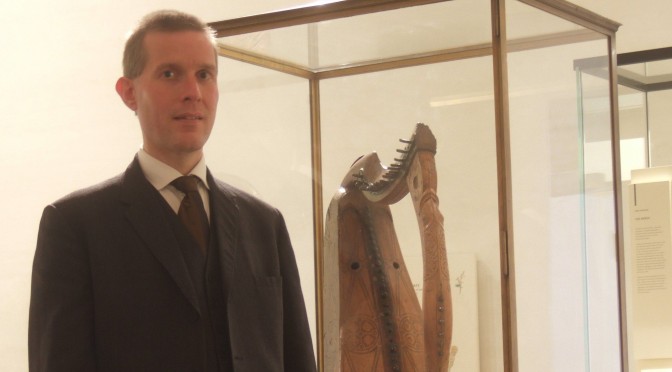Last week was Scoil na gCláirseach in Kilkenny.
Tag: Queen Mary harp replica
Scotland’s Treasures
For the next month, you can view the BBC TV documentary Scotland’s Treasures on iPlayer.
Vermilion
Karen Loomis discovered the presence of mercury in the red pigment on the Queen Mary harp, when she did X-ray fluorescence analysis in 2010. This pretty much confirms that the pigment is vermilion, a mercury sulphide compound.
Karen reported that only the pigment on the curved body of the fish on the forepillar indicated mercury; the pigment on the flat panels of the forepillar contained no mercury. A rendering of the CT-scan data printed in her Galpin Society Journal article (vol LXV, 2012, p.166) shows high-density spots in the crevaces between the interlace of the fish shoulders, and also around the fish eye.
As soon as Karen told me about this I thought of re-painting my replica. Continue reading Vermilion
Restringing the Queen Mary harp
I realised it would be somewhat hypocritical of me to recommend my new Trinity College & Queen Mary harp stringing and tuning schedule, with na comhluighe (the sisters) at middle c, if I didn’t put it onto my replica of the Queen Mary harp.
So, last Sunday’s work was to remove all of the old silver trebles and gold basses, and put on the new brass trebles and silver basses according to the new scheme.
Events in Dundee, St Andrews and London
I am working hard this week, preparing for three events in three days. On Saturday I am in Dundee; on Sunday in St Andrews and on Monday in London.
Playing the harp in Kisimul Castle
Steach gu Ciosamul an aighir,
Far a faighte cuirm ri gabhail
Ol fìon o oidhche gus an latha,
Pìobaireachd na feadan lagach,
‘s clàrsach bhinn ga gleusadh mar ris…
I was at Castlebay this past weekend, to play the harp at the Galley Castles Conference organised by the Islands Book Trust. I played three times for three different events during the conference, all of them fairly informal. Though I didn’t get a chance to formally present a paper on my research into the medieval Hebridean harp music and instrument tradition, I was pleased to be able to discuss my research and work with a number of interested academics working in this area on the history and archaeology of the castles and society of the medieval Western Isles and the Lordship of the Isles.
3D model of the harp
Here’s my latest attempt at 3D photography. It’s not very good but It was a first attempt! Continue reading 3D model of the harp
An cruit bheag ‘s an cruit mhor
Practicing for my Carolan concert this coming Thursday lunchtime, I have got the Downhill harp back from my student who usually has it and I was reminded of how I often talk about the importance of using an appropriate instrument for different repertory. Continue reading An cruit bheag ‘s an cruit mhor
Before & after
Here are the two Youtubes, showing the sound of the harp before and after the work. Let me know what you think.
Opening up the harp
I have been thinking for a few years now about the shape of the inside of my harp, in light of the new information we have from Karen Loomis’s PhD research at the University of Edinburgh.
When I commissioned the harp from Davy Patton in 2006-7, the thing we were most lacking was info about the inside – the shapes of the joints, and the profile and thickness of the soundbox. Basically, we had to make a lot of educated guesses.
Since then, we have the CT-scans and other technical studies of the Queen Mary harp that Karen has been working on, and many of our guesses have turned out to be pleasingly correct, such as our choice of timber – willow for the soundbox, and a bent limb for the pillar – but we were quite wrong in our decisions on how to shape the soundbox interior.
Luckily, we had erred very much on the side of leaving the wood too thick, so last week I took the harp to Natalie Surina, of Ériú Harps in Oughterard, Connemara, for her to cut a lot of wood from inside the soundbox.








